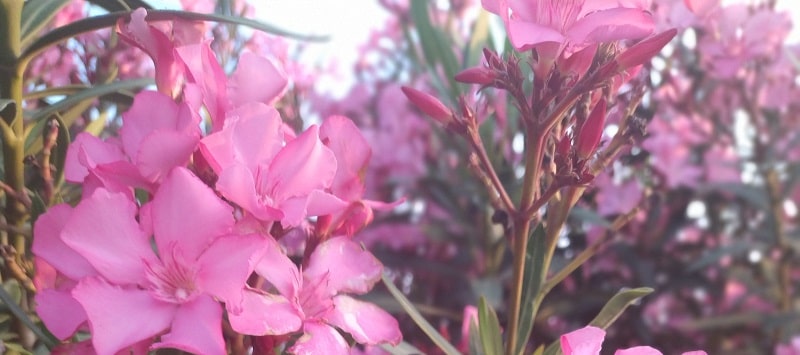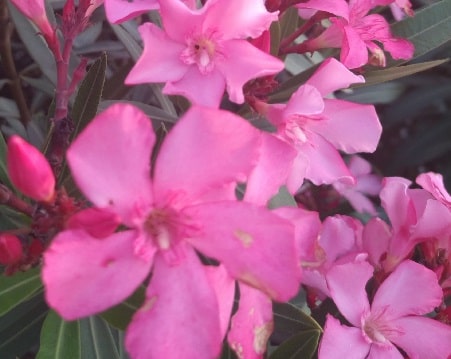Oleander (Nerium oleander) is not typically suitable for growing outdoors in New York. Oleanders are native to subtropical and tropical regions and require warm temperatures and a longer growing season to thrive. New York’s climate, particularly in the northern parts of the state, is characterized by cold winters and shorter growing seasons, which are not conducive to the successful growth of oleander plants.
In New York, oleanders are typically grown as container plants or greenhouse specimens that can be moved indoors during the colder months. This allows gardeners in New York to enjoy the beauty of oleander flowers and foliage while providing the necessary protection from frost and cold temperatures.

It’s worth noting that even as a container plant or greenhouse specimen, caution should be exercised with oleander due to its toxic nature. All parts of the oleander plant, including the leaves, flowers, and sap, contain toxic compounds and should be kept out of reach of children and pets.
If you are interested in growing plants with similar visual appeal to oleander in New York, it would be best to explore native or cold-hardy alternatives that are better suited to the local climate and conditions. Consulting with local nurseries or gardening experts can provide specific recommendations for suitable plant options in your area.
Where is oleander most commonly used in New York?
Oleander (Nerium oleander) is not commonly used for outdoor landscaping in New York due to its inability to tolerate the state’s cold winters and shorter growing season. However, oleander can be found in certain indoor settings or in specialized environments where temperature and growing conditions can be controlled. Here are a few places where oleander might be used in New York:
- Indoor Gardens and Conservatories: Some botanical gardens, indoor gardens, and conservatories in New York may cultivate oleander as a tropical plant specimen. These controlled environments provide the necessary warmth and humidity for oleander to thrive.
- Greenhouses: Some gardening enthusiasts or commercial growers in New York may cultivate oleander in greenhouses. Greenhouses offer protection from cold temperatures and allow for extended growing seasons, making it possible to grow plants that are not suited for the outdoor climate.
- Container Gardening: Oleander can be grown as a container plant in New York. Gardeners may choose to grow oleander in containers outdoors during the warmer months and then bring them indoors during winter to protect them from frost and cold temperatures.

It’s important to note that oleander is toxic if ingested or if there is contact with the sap, so caution should be exercised when handling the plant. All parts of the oleander plant, including the leaves, flowers, and sap, contain toxic compounds and should be kept out of reach of children and pets.
For outdoor landscaping in New York, it is advisable to explore native plant species or other plants that are better adapted to the region’s climate and growing conditions. Consulting with local nurseries, gardening experts, or university extension offices can provide specific recommendations for suitable plants for your area in New York. Oleander flowers in New York >>
New York’ta zakkum çiçeği satın alabilir miyim?
While it is not common to find fresh oleander flowers (Nerium oleander) available for purchase in New York, you may be able to find preserved or dried oleander flowers in some floral or craft shops. Preserved or dried flowers can be used for decorative purposes, such as in floral arrangements, crafts, or displays.
It’s important to note that oleander flowers, as well as other parts of the oleander plant, contain toxic compounds and should be handled with caution. If you come across preserved oleander flowers, make sure to keep them out of reach of children and pets and avoid direct contact with the flowers or their sap.
If you are specifically interested in purchasing fresh oleander flowers, it may be more challenging to find them in New York due to the limitations of the plant’s cultivation in the state. In such cases, you may consider exploring online sources or contacting specialized florists who might be able to assist you in sourcing fresh oleander flowers, although availability may be limited.
Always exercise caution when handling oleander, as its toxicity requires careful handling and should not be consumed or ingested.
How to care for and prune oleander in New York State
Caring for and pruning oleander (Nerium oleander) in New York State requires special attention due to the region’s colder climate. Here are some guidelines to help you care for and prune oleander in New York:
- Planting and Location: If you choose to grow oleander outdoors in New York, select a location that receives full sun exposure, as oleanders require at least six hours of direct sunlight daily. Choose a sheltered spot that provides some protection from strong winds.
- Container Gardening: Growing oleander in containers is a more viable option in New York as it allows for easier protection during winter months. Use a large container with well-draining soil. During the warmer months, place the container outdoors in a sunny spot, and bring it indoors before the first frost. Provide adequate light indoors by placing it near a south-facing window or using artificial lighting.
- Watering: Oleanders are drought-tolerant once established but still require regular watering. Water deeply and thoroughly, allowing the soil to dry slightly between waterings. Avoid overwatering, as oleanders are susceptible to root rot.
- Fertilization: Feed your oleander plants with a balanced, slow-release fertilizer in the spring when new growth begins. Follow the manufacturer’s instructions for application rates. Avoid excessive fertilization, as it can lead to excessive growth and reduced flowering.
- Winter Protection: In New York, outdoor-grown oleanders need protection during winter. Before the first frost, bring potted oleander plants indoors and place them in a cool, well-lit area. Keep them away from drafts and heaters. Water sparingly during the winter months, as growth slows down.
- Pruning: Pruning oleander is best done in late winter or early spring before new growth starts. Here are some pruning tips:
- Remove dead, damaged, or diseased branches.
- Thin out crowded branches to improve air circulation.
- Maintain the desired shape by selectively pruning branches back to a healthy bud or node.
- Remove any suckers or shoots emerging from the base of the plant.
- Use sharp, clean pruning tools to make smooth cuts.
Remember to wear protective gloves and clothing when pruning oleander to avoid contact with the toxic sap.
It’s important to note that while oleander can be grown in New York, it requires extra care and protection due to the colder climate. If you’re unsure about successfully growing oleander outdoors, container gardening or considering alternative cold-hardy plant options might be more practical for your location in New York. Does oleander grow in New York? Is oleander a popular tree? >>
